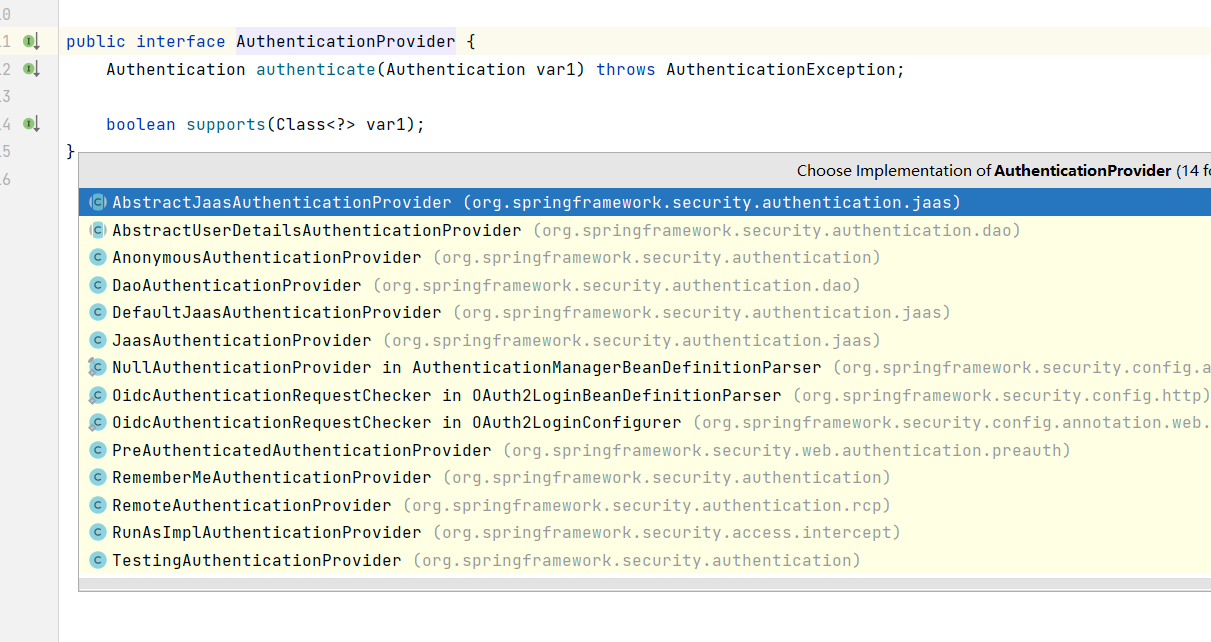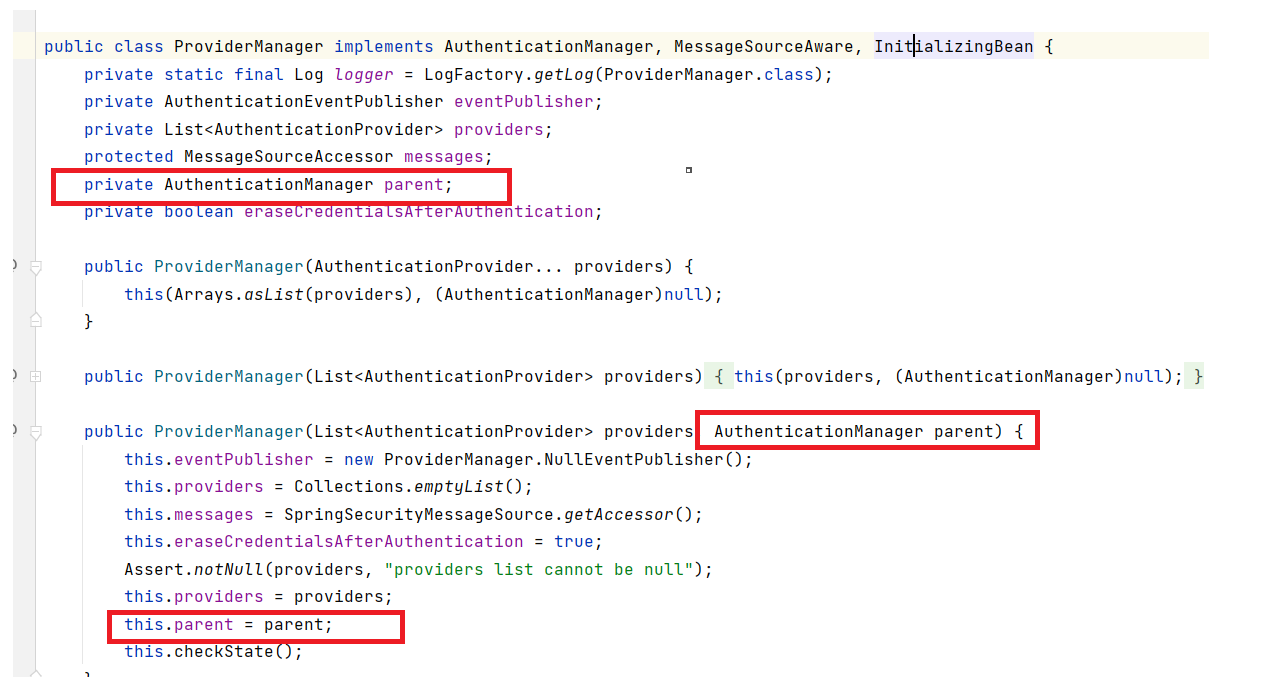Spring Security---用户名密码登录流程源码解析
- 引言
- 探究
- 无处不在的 Authentication
- 登录流程
- 校验
- 用户信息保存
引言
你在服务端的安全管理使用了 Spring Security,用户登录成功之后,Spring Security 帮你把用户信息保存在 Session 里,但是具体保存在哪里,要是不深究你可能就不知道, 这带来了一个问题,如果用户在前端操作修改了当前用户信息,在不重新登录的情况下,如何获取到最新的用户信息?
探究
无处不在的 Authentication
玩过 Spring Security 的小伙伴都知道,在 Spring Security 中有一个非常重要的对象叫做 Authentication,我们可以在任何地方注入 Authentication 进而获取到当前登录用户信息,Authentication 本身是一个接口,它有很多实现类:

在这众多的实现类中,我们最常用的就是 UsernamePasswordAuthenticationToken 了,但是当我们打开这个类的源码后,却发现这个类平平无奇,他只有两个属性、两个构造方法以及若干个 get/set 方法;当然,他还有更多属性在它的父类上。
但是从它仅有的这两个属性中,我们也能大致看出,这个类就保存了我们登录用户的基本信息。那么我们的登录信息是如何存到这两个对象中的?这就要来梳理一下登录流程了。
登录流程
在 Spring Security 中,认证与授权的相关校验都是在一系列的过滤器链中完成的,在这一系列的过滤器链中,和认证相关的过滤器就是 UsernamePasswordAuthenticationFilter::
public class UsernamePasswordAuthenticationFilter extends AbstractAuthenticationProcessingFilter {
//默认的用户名和密码对应的key
public static final String SPRING_SECURITY_FORM_USERNAME_KEY = "username";
public static final String SPRING_SECURITY_FORM_PASSWORD_KEY = "password";
//当前过滤器默认拦截的路径
private static final AntPathRequestMatcher DEFAULT_ANT_PATH_REQUEST_MATCHER = new AntPathRequestMatcher("/login", "POST");
//默认的请求参数名称规定
private String usernameParameter = "username";
private String passwordParameter = "password";
//默认只能是post请求
private boolean postOnly = true;
public UsernamePasswordAuthenticationFilter() {
//设置默认的拦截路径
super(DEFAULT_ANT_PATH_REQUEST_MATCHER);
}
public UsernamePasswordAuthenticationFilter(AuthenticationManager authenticationManager) {
//设置默认的拦截路径,和处理认证的管理器
super(DEFAULT_ANT_PATH_REQUEST_MATCHER, authenticationManager);
}
public Authentication attemptAuthentication(HttpServletRequest request, HttpServletResponse response) throws AuthenticationException {
//判断请求方式
if (this.postOnly && !request.getMethod().equals("POST")) {
throw new AuthenticationServiceException("Authentication method not supported: " + request.getMethod());
} else {
//从请求参数中获取对应的值
String username = this.obtainUsername(request);
username = username != null ? username : "";
username = username.trim();
String password = this.obtainPassword(request);
password = password != null ? password : "";
//构造用户名和密码登录的认证令牌
UsernamePasswordAuthenticationToken authRequest = new UsernamePasswordAuthenticationToken(username, password);
//设置details---deltails里面默认存放sessionID和remoteaddr
//authRequest 就是构造好的认证令牌
this.setDetails(request, authRequest);
//校验
//authRequest 就是构造好的认证令牌
return this.getAuthenticationManager().authenticate(authRequest);
}
}
@Nullable
protected String obtainPassword(HttpServletRequest request) {
return request.getParameter(this.passwordParameter);
}
@Nullable
protected String obtainUsername(HttpServletRequest request) {
return request.getParameter(this.usernameParameter);
}
protected void setDetails(HttpServletRequest request, UsernamePasswordAuthenticationToken authRequest) {
authRequest.setDetails(this.authenticationDetailsSource.buildDetails(request));
}
public void setUsernameParameter(String usernameParameter) {
Assert.hasText(usernameParameter, "Username parameter must not be empty or null");
this.usernameParameter = usernameParameter;
}
public void setPasswordParameter(String passwordParameter) {
Assert.hasText(passwordParameter, "Password parameter must not be empty or null");
this.passwordParameter = passwordParameter;
}
public void setPostOnly(boolean postOnly) {
this.postOnly = postOnly;
}
public final String getUsernameParameter() {
return this.usernameParameter;
}
public final String getPasswordParameter() {
return this.passwordParameter;
}
}
根据这段源码我们可以看出:
- 首先通过 obtainUsername 和 obtainPassword 方法提取出请求里边的用户名/密码出来,提取方式就是 request.getParameter ,这也是为什么 Spring Security 中默认的表单登录要通过 key/value 的形式传递参数,而不能传递 JSON 参数,如果像传递 JSON 参数,修改这里的逻辑即可
- 获取到请求里传递来的用户名/密码之后,接下来就构造一个
UsernamePasswordAuthenticationToken对象,传入 username 和 password,username对应了UsernamePasswordAuthenticationToken中的principal属性,而password则对应了它的credentials属性。
public class UsernamePasswordAuthenticationToken extends AbstractAuthenticationToken {
private static final long serialVersionUID = 550L;
private final Object principal;
private Object credentials;
public UsernamePasswordAuthenticationToken(Object principal, Object credentials) {
super((Collection)null);
this.principal = principal;
this.credentials = credentials;
this.setAuthenticated(false);
}
public UsernamePasswordAuthenticationToken(Object principal, Object credentials, Collection<? extends GrantedAuthority> authorities) {
super(authorities);
this.principal = principal;
this.credentials = credentials;
super.setAuthenticated(true);
}
public Object getCredentials() {
return this.credentials;
}
public Object getPrincipal() {
return this.principal;
}
public void setAuthenticated(boolean isAuthenticated) throws IllegalArgumentException {
Assert.isTrue(!isAuthenticated, "Cannot set this token to trusted - use constructor which takes a GrantedAuthority list instead");
super.setAuthenticated(false);
}
public void eraseCredentials() {
super.eraseCredentials();
this.credentials = null;
}
}
- 接下来
setDetails方法给details属性赋值,UsernamePasswordAuthenticationToken本身是没有details属性的,这个属性在它的父类AbstractAuthenticationToken中。details是一个对象,这个对象里边放的是WebAuthenticationDetails实例,该实例主要描述了两个信息,请求的remoteAddress以及请求的sessionId。

- 最后一步,就是调用 authenticate 方法去做校验了。
好了,从这段源码中,大家可以看出来请求的各种信息基本上都找到了自己的位置,找到了位置,这就方便我们未来去获取了。
接下来我们再来看请求的具体校验操作。
校验
在前面的 attemptAuthentication 方法中,该方法的最后一步开始做校验,校验操作首先要获取到一个 AuthenticationManager,这里拿到的是 ProviderManager ,所以接下来我们就进入到 ProviderManager 的 authenticate 方法中,当然这个方法也比较长,我这里仅仅摘列出来几个重要的地方:

public Authentication authenticate(Authentication authentication) throws AuthenticationException {
//获取到主体(用户名)和凭证(密码)组成的一个令牌对象的class类对象
Class<? extends Authentication> toTest = authentication.getClass();
AuthenticationException lastException = null;
AuthenticationException parentException = null;
Authentication result = null;
Authentication parentResult = null;
int currentPosition = 0;
//获取所有可用来校验令牌对象的provider数量
int size = this.providers.size();
//获取迭代器
Iterator var9 = this.getProviders().iterator();
//遍历所有provider
while(var9.hasNext()) {
AuthenticationProvider provider = (AuthenticationProvider)var9.next();
//判断当前provider是否支持当前令牌对象的校验
if (provider.supports(toTest)) {
if (logger.isTraceEnabled()) {
Log var10000 = logger;
String var10002 = provider.getClass().getSimpleName();
++currentPosition;
var10000.trace(LogMessage.format("Authenticating request with %s (%d/%d)", var10002, currentPosition, size));
}
try {
//如果支持就进行认证校验处理
result = provider.authenticate(authentication);
//校验成功返回一个新的authentication
//将原先的主体由用户名换成了userdetails对象
if (result != null) {
//拷贝details到新的令牌对象
this.copyDetails(authentication, result);
break;
}
} catch (InternalAuthenticationServiceException | AccountStatusException var14) {
this.prepareException(var14, authentication);
throw var14;
} catch (AuthenticationException var15) {
lastException = var15;
}
}
}
//认证失败但是 provider 的 parent不为null
if (result == null && this.parent != null) {
try {
//调用 provider 的 parent进行验证--parent就是providerManager
parentResult = this.parent.authenticate(authentication);
result = parentResult;
} catch (ProviderNotFoundException var12) {
} catch (AuthenticationException var13) {
parentException = var13;
lastException = var13;
}
}
//认证成功
if (result != null) {
//擦除凭证---密码
if (this.eraseCredentialsAfterAuthentication && result instanceof CredentialsContainer) {
((CredentialsContainer)result).eraseCredentials();
}
//发布认证成功的结果
if (parentResult == null) {
this.eventPublisher.publishAuthenticationSuccess(result);
}
//返回新生产的令牌对象
return result;
} else {
//认证失败
if (lastException == null) {
lastException = new ProviderNotFoundException(this.messages.getMessage("ProviderManager.providerNotFound", new Object[]{toTest.getName()}, "No AuthenticationProvider found for {0}"));
}
if (parentException == null) {
this.prepareException((AuthenticationException)lastException, authentication);
}
throw lastException;
}
}
这个方法就比较魔幻了,因为几乎关于认证的重要逻辑都将在这里完成:
- 首先获取 authentication 的 Class,判断当前 provider 是否支持该 authentication。

- 如果支持,则调用 provider 的 authenticate方法开始做校验,校验完成后,会返回一个新的Authentication。一会来和大家捋这个方法的具体逻辑
- 这里的 provider 可能有多个,如果 provider 的 authenticate 方法没能正常返回一个Authentication,则调用 provider 的 parent 的 authenticate 方法继续校验。
- copyDetails 方法则用来把旧的 Token 的 details 属性拷贝到新的 Token 中来。
- 接下来会调用 eraseCredentials 方法擦除凭证信息,也就是你的密码,这个擦除方法比较简单,就是将 Token 中的credentials 属性置空
- 最后通过 publishAuthenticationSuccess 方法将登录成功的事件广播出去。
大致的流程,就是上面这样,在 for 循环中,第一次拿到的 provider 是一个 AnonymousAuthenticationProvider,这个 provider 压根就不支持 UsernamePasswordAuthenticationToken,也就是会直接在 provider.supports 方法中返回 false,结束 for 循环,然后会进入到下一个 if 中,直接调用 parent 的 authenticate 方法进行校验。
而 parent 就是 ProviderManager,所以会再次回到这个 authenticate 方法中。再次回到 authenticate 方法中,provider 也变成了 DaoAuthenticationProvider,这个 provider 是支持 UsernamePasswordAuthenticationToken 的,所以会顺利进入到该类的 authenticate 方法去执行,而 DaoAuthenticationProvider 继承自 AbstractUserDetailsAuthenticationProvider 并且没有重写 authenticate 方法,所以 我们最终来到 AbstractUserDetailsAuthenticationProvider#authenticate 方法中:

public Authentication authenticate(Authentication authentication)
throws AuthenticationException {
String username = (authentication.getPrincipal() == null) ? "NONE_PROVIDED"
: authentication.getName();
user = retrieveUser(username,(UsernamePasswordAuthenticationToken) authentication);
preAuthenticationChecks.check(user);
additionalAuthenticationChecks(user,(UsernamePasswordAuthenticationToken) authentication);
postAuthenticationChecks.check(user);
//如果用户没有使用过,将其放进缓存中
if (!cacheWasUsed) {
this.userCache.putUserInCache(user);
}
Object principalToReturn = user;
if (forcePrincipalAsString) {
principalToReturn = user.getUsername();
}
return createSuccessAuthentication(principalToReturn, authentication, user);
}
-
首先从 Authentication 提取出登录用户名。
-
然后通过拿着 username 去调用 retrieveUser 方法去获取当前用户对象,这一步会调用我们自己在登录时候的写的 loadUserByUsername 方法,所以这里返回的 user 其实就是你的登录对象

-
接下来调用 preAuthenticationChecks.check 方法去检验 user 中的各个账户状态属性是否正常,例如账户是否被禁用、账户是否被锁定、账户是否过期等等

- additionalAuthenticationChecks 方法则是做密码比对的,好多小伙伴好奇 Spring Security 的密码加密之后,是如何进行比较的,看这里就懂了。

- 最后在 postAuthenticationChecks.check 方法中检查密码是否过期。

- 判断用户是否在缓存中存在,如果不存在,就放入缓存中
- 接下来有一个 forcePrincipalAsString 属性,这个是是否强制将 Authentication 中的 principal 属性设置为字符串,这个属性我们一开始在 UsernamePasswordAuthenticationFilter 类中其实就是设置为字符串的(即 username),但是默认情况下,当用户登录成功之后, 这个属性的值就变成当前用户这个对象了。之所以会这样,就是因为 forcePrincipalAsString 默认为 false,不过这块其实不用改,就用 false,这样在后期获取当前用户信息的时候反而方便很多。
- 最后,通过 createSuccessAuthentication 方法构建一个新的 UsernamePasswordAuthenticationToken,此时认证主体就由用户名变为了userDetails对象
好了,那么登录的校验流程现在就基本和大家捋了一遍了。那么接下来还有一个问题,登录的用户信息我们去哪里查找?
用户信息保存
要去找登录的用户信息,我们得先来解决一个问题,就是上面我们说了这么多,这一切是从哪里开始被触发的?
我们来到 UsernamePasswordAuthenticationFilter 的父类 AbstractAuthenticationProcessingFilter 中,这个类我们经常会见到,因为很多时候当我们想要在 Spring Security 自定义一个登录验证码或者将登录参数改为 JSON 的时候,我们都需自定义过滤器继承自 AbstractAuthenticationProcessingFilter ,毫无疑问,UsernamePasswordAuthenticationFilter#attemptAuthentication 方法就是在 AbstractAuthenticationProcessingFilter 类的 doFilter 方法中被触发的:
private void doFilter(HttpServletRequest request, HttpServletResponse response, FilterChain chain) throws IOException, ServletException {
//不需要认证就直接放行
if (!this.requiresAuthentication(request, response)) {
chain.doFilter(request, response);
} else {
try {
//获取认证的结果---null或者新生产的令牌对象
Authentication authenticationResult = this.attemptAuthentication(request, response);
//认证失败
if (authenticationResult == null) {
return;
}
this.sessionStrategy.onAuthentication(authenticationResult, request, response);
if (this.continueChainBeforeSuccessfulAuthentication) {
chain.doFilter(request, response);
}
this.successfulAuthentication(request, response, chain, authenticationResult);
} catch (InternalAuthenticationServiceException var5) {
this.logger.error("An internal error occurred while trying to authenticate the user.", var5);
this.unsuccessfulAuthentication(request, response, var5);
} catch (AuthenticationException var6) {
this.unsuccessfulAuthentication(request, response, var6);
}
}
}
从上面的代码中,我们可以看到,当 attemptAuthentication 方法被调用时,实际上就是触发了 UsernamePasswordAuthenticationFilter#attemptAuthentication 方法,当登录抛出异常的时候,unsuccessfulAuthentication 方法会被调用,而当登录成功的时候,successfulAuthentication 方法则会被调用,那我们就来看一看 successfulAuthentication 方法:
protected void successfulAuthentication(HttpServletRequest request,
HttpServletResponse response, FilterChain chain, Authentication authResult)
throws IOException, ServletException {
//将新生产的令牌对象放入spring security的上下文环境中
SecurityContextHolder.getContext().setAuthentication(authResult);
rememberMeServices.loginSuccess(request, response, authResult);
// Fire event
if (this.eventPublisher != null) {
eventPublisher.publishEvent(new InteractiveAuthenticationSuccessEvent(
authResult, this.getClass()));
}
successHandler.onAuthenticationSuccess(request, response, authResult);
}
在这里有一段很重要的代码,就是 SecurityContextHolder.getContext().setAuthentication(authResult); ,登录成功的用户信息被保存在这里,也就是说,在任何地方,如果我们想获取用户登录信息,都可以从 SecurityContextHolder.getContext() 中获取到,想修改,也可以在这里修改。
最后大家还看到有一个 successHandler.onAuthenticationSuccess,这就是我们在 SecurityConfig 中配置登录成功回调方法,就是在这里被触发的
当认证失败时,会调用登录失败处理器,并清空上下文环境中的对象
protected void unsuccessfulAuthentication(HttpServletRequest request, HttpServletResponse response, AuthenticationException failed) throws IOException, ServletException {
SecurityContextHolder.clearContext();
this.logger.trace("Failed to process authentication request", failed);
this.logger.trace("Cleared SecurityContextHolder");
this.logger.trace("Handling authentication failure");
this.rememberMeServices.loginFail(request, response);
this.failureHandler.onAuthenticationFailure(request, response, failed);
}
最后
以上就是可爱小懒猪最近收集整理的关于Spring Security---用户名密码登录流程源码解析引言探究的全部内容,更多相关Spring内容请搜索靠谱客的其他文章。








发表评论 取消回复